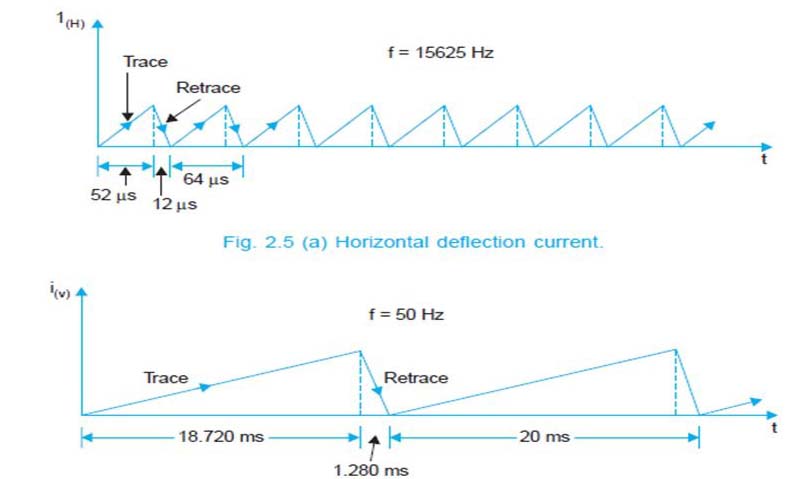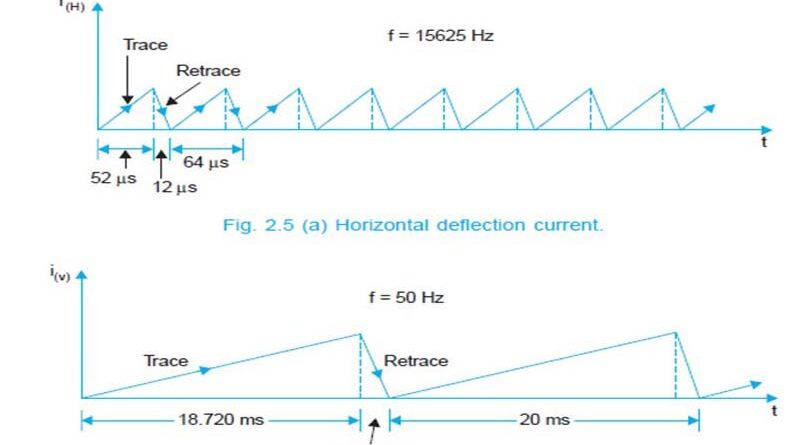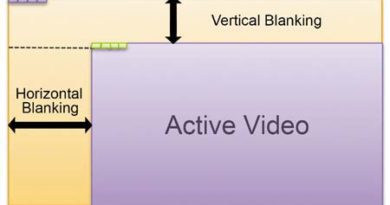Horizontal And Vertical Scanning Frequencies
The field rate of 60 Hz is the vertical scanning frequency. This is the rate at which the electron beam completes its cycles of vertical motion, from top to bottom and tack to top again, ready to start the next vertical scan. Vertical deflection circuits for either the camera tube or picture tube operate at 60 Hz. The time of each vertical scanning cycle for one field is 1/60s. The number of horizontal scanning lines in a field is one-half the total 525 lines for a complete frame, since one field contains every other line. This results in 262V2 horizontal lines for each vertical field. Since the time for a field is 1/60s and since it contains 262V., lines, the number of lines per second is: 2627, x 60 = 15,750
Or, considering 525 lines for a successive pair of fields, which is a frame, we can multiply the frame rate of 30 by 525, which equals the same 15,750 lines scanned in 1 s. This frequency of 15,750 Hz is the rate at which the electron beam completes its cycles of horizontal motion, from left to right and back to left again, ready to start the next horizontal scan. Therefore, horizontal deflection circuits for either the camera tube or picture tube operate at 15,750 Hz. The time for each horizontal scanning line is 7,2.752 s. In terms of microseconds,
H time =1,000,000 /15,750 = 63.5 As approx
This time in microseconds indicates that the video signal for picture elements within a horizontal line can have high frequencies in the order of megahertz. If there were more lines, the scanning time would be shorter, resulting in higher video frequencies. Actually, in our 525-line system, the highest video frequency is limited to approximately 4 MHz because of the restriction of 6 MHz. for the commercial television broadcast channels.

Horizontal and Vertical Synchronization
Time in scanning corresponds to distance in the image. As the electron beam in the camera tube scans the image, the beam covers different elements of the image and provides the corresponding picture information. Therefore, when the electron beam scans the screen of the picture tube at the receiver, the scanning must be exactly timed to assemble the picture information in the correct position. Otherwise, the electron beam in the picture tube can be scanning the part of the screen where a man’s mouth should be while at that time the picture information being received corresponds to his nose. To keep the transmitter and receiver scanning in step with each other, special synchronizing signals must be transmitted with the picture information for the receiver. These timing signals are rectangular pulses used to control both transmitter and receiver scanning.
The synchronizing pulses are transmitted as a part of the complete picture signal for the receiver, but they occur during the blanking time when no picture information is transmitted. The picture is blanked out for this period while the electron beam retraces. A horizontal synchronizing pulse at the end of each horizontal line begins the horizontal retrace time, and a vertical synchronizing pulse at the end of each field begins the vertical retrace time. As a result, the receiver and transmitter scanning are synchronized.
Without the vertical field synchronization, the reproduced picture at the receiver does not hold vertically, and it rolls up or down on the picture tube screen. If the scanning lines are not synchronized, the picture will not hold horizontally, as it slips to the left or right and then tears apart into diagonal segments. In summary, then, the horizontal line-scanning frequency is 15,750 Hz, and the frequency of the horizontal synchronizing pulses is also 15,750 Hz. The frame repetition rate is 30 per second, but the vertical field-scanning frequency is 60 Hz, and the frequency of the vertical synchronizing pulses is also 60 Hz. It should be noted that the scanning frequencies of 15,750 and 60 Hz are exact for monochrome but only approximate for color television. In color broadcasting, the horizontal line-scanning frequency is exactly 15,734.26 Hz, with 59.94 Hz for the vertical field frequency. These exact scanning frequencies are used to minimize interference between the color sub carrier at exactly 3.579545 MHz and the inter carrier sound signal at exactly 4.5 MHz. However, the horizontal and vertical scanning frequencies can be considered generally as 15,750 and 60 Hz. The reason is that the deflection circuits are automatically synchronized at the required scanning frequencies for both monochrome and color broadcasting.


